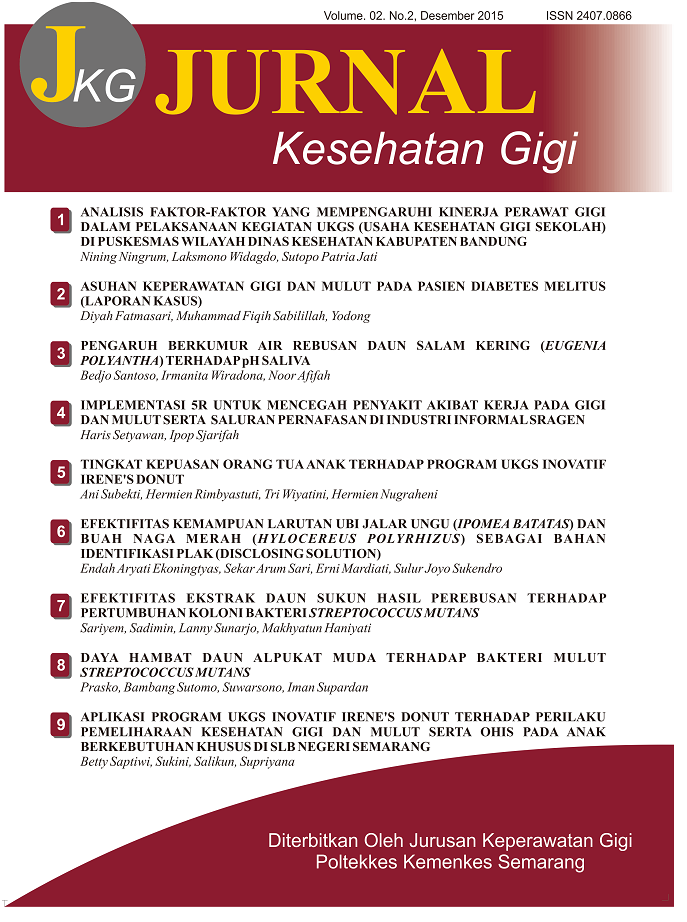EFEKTIFITAS LARUTAN UBI JALAR UNGU (IPOMEA BATATAS) DENGAN BUAH NAGA BERDAGING MERAH (HYLOCEREUS POLYRHIZUS) SEBAGAI BAHAN IDENTIFIKASI PLAK (DISCLOSING SOLUTION)
DOI:
https://doi.org/10.31983/jkg.v2i02.3297Keywords:
Sweet potato purple, red dragon fruit, Plaque IndexAbstract
TITLE
Effectiveness of purple sweet potatoes (Ipomea batatas) and red dragon fruit (Hylocereus polyrhizus) as plaque identification agent (disclosing solution)
ABSTRACT
The content of the dye in purple sweet potato anthocyanins and carotenoids content of dyes in the red dragon fruit, has the potential a source of natural dyes. Plaque is usually formed on a third surface of the gingival and the tooth surface is rough, form biofilm, known as plaque. Plaque can absorb dyes that can indicate the presence of biofilm. The research objective was to determine differences in the ability of the solution to the purple sweet potato red fleshed dragon fruit as materials identification plaque (disclosing solution).
The method used is Experimental Research. Design used is Posttest Only Design. Samples were taken 30 people and divided into 2 groups. Group 1st amounted to 15 people given treatment solution dripping purple sweet potato, and the second group totaled 15 people given treatment solution dripping red dragon fruit. Analysis of the data used in this study is Test Independent Test.
The results showed the averages value of the plaque index in a solution of purple sweet potato 2.221 and the average value of the plaque index in the red dragon fruit 2.875. Result of Independent T-test has Sig 0.13 means that there are differences in the ability to use the solution with a purple sweet potato red fleshed dragon fruit as materials identification plaque (p <0.05). As a material it is necessary to identify plaque dyes that can be embedded in dental plaque, antosianin amount of content that has the in herentability of the dye solution and based on research results more red dragon fruit can identify plaque compared with a solution of purple sweet potato.
Â
Keywords: Sweet potato purple, red dragon fruit, Plaque IndexReferences
Agus Riyanto, 2011, Aplikasi Metodologi Penelitian Kesehatan, Muha Medica, Yogyakarta.
Arikunto, Suharsimi, 2002, Prosedur Penelitian Suatu Pendekatan Praktek, Rineka Cipta, Jakarta.
Basuki, WD., 2012, Efektifitas Buah Naga Berdaging Merah Sebagai Pengganti Disklosing Solution untuk Melihat Plak, KTI, Poltekkes, Semarang.
Donna, P, 2007, Gigi Sehat merawat gigi sehari-hari, Buku Kompas, Jakarta
Khaldun, I., Erlidawati, dan Munzair, 2013, Kestabilan zat warna alami dan umbi ketela ungu. Chima Didactica Acta 1(1) .34 – 40.
Kristanto, Daniel, 2009, Buah Naga Pembudiyaan di Pot di Kebun, Penebar Swadaya, Jakarta.
Notoatmojo, S., .2010, Metodologi penelitian kesehatan, Renika Cipta, Jakarta.
Pratiwi, A I., 2014, Manfaat Berkumur Sari Buah Delima Merah Terhadap Penurunan Akumulasi Plak. Skripsi Unmas
Putri, M.H., Herijulianti E, Nurjanah N., 2011. Ilmu Pencegahan Penyakit Jaringan Keras dan Jaringan Pendukung Gigi, EGC, Jakarta.
Riyanto, A., 2011, Aplikasi Metodeologi Penelitian Kesehatan, Muha Medica, Yogyakarta.
Rukmana, R., 1997, Budidaya dan pascapanen ubi jalar, Kanisius, Jogjakarta.
Saifudin, Aziz, Viesa., 2011, Standardisasi Bahan Obat Alam, Graha Ilmu, Yogyakarta.
Samber NL, Semangun H., Prasetyo B., 2013, Ubi Jalar Ungu Papua Sebagai Sumber Antioksidan. Jurnal, Fjip, uns. ac. id/index. Php/ probio/ article /view /3210.di akses pada tanggal 9 Desember 2014.
Santoso w, Teti Estiasih., Kopigmentasi Ubi Jalar Ungu (Ipomea Batatas var.Ayamurasaki) Dengan Kopigmen Na-Kaseinat Dan Protein Whey Serta Stabilitasnya Terhadap Pemanasan. 2014. 2(4).127-127
Sarwono, B., 2005, Ubi Jalar Cara Budi Daya yang Tepat Efisien dan Ekonomis Seni Agribisnis, Jakarta, Penerbit Siuaelaya.
Downloads
Published
Issue
Section
License
Authors retain copyright and grant the journal right of first publication with the work simultaneously licensed under a Creative Commons Attribution-ShareAlike 4.0 International License. that allows others to share — copy and redistribute the material in any medium or format and adapt — remix, transform, and build upon the material for any purpose, even commercially with an acknowledgment of the work's authorship and initial publication in this journal.


